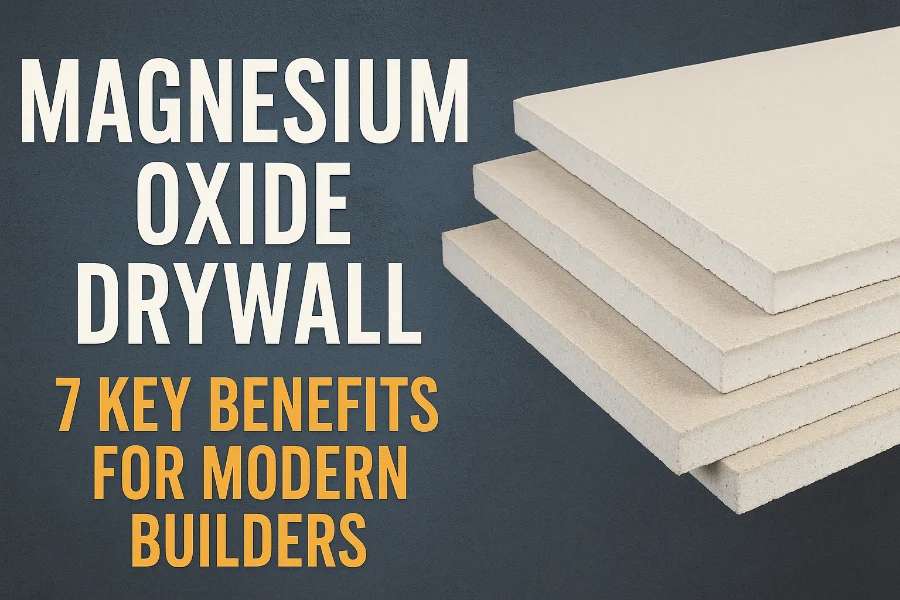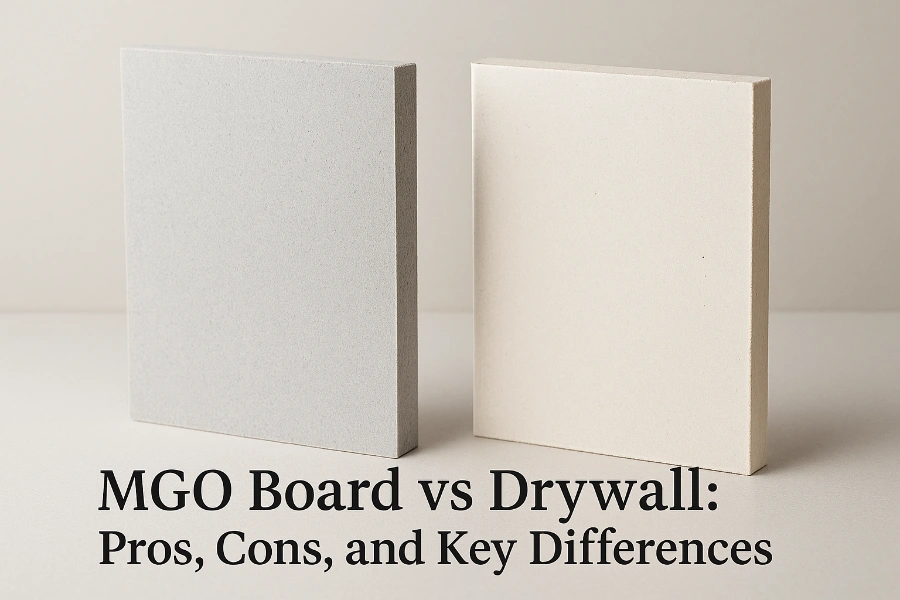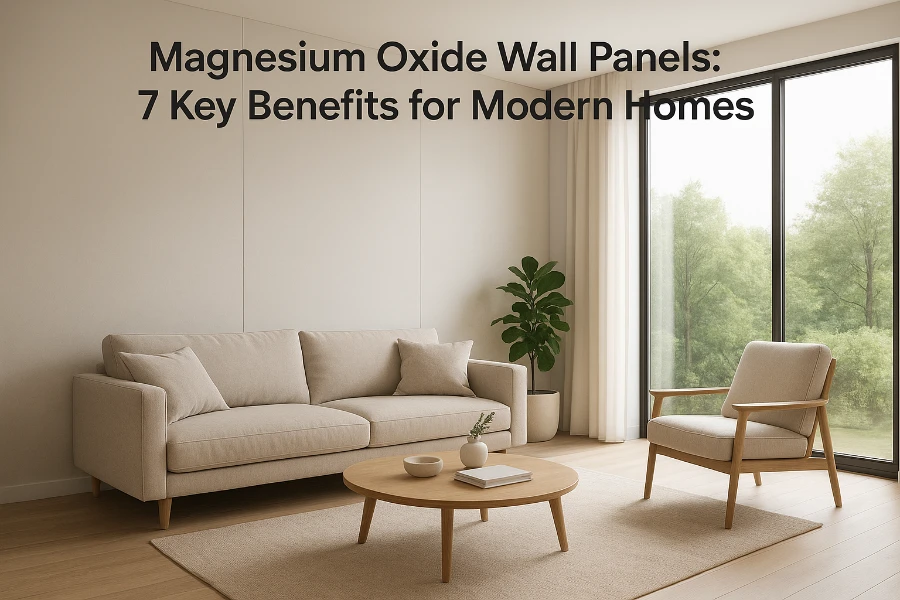Table of Contents
1. Introduction
In today’s construction industry, the demand for safer, stronger, and more sustainable building materials is rapidly increasing. Traditional gypsum drywall has been the standard for decades, but it comes with limitations in terms of durability, moisture resistance, and fire safety.
Magnesium oxide drywall (MgO drywall) emerges as a next-generation alternative, manufactured from natural mineral compounds that deliver excellent performance in fire protection, structural stability, and environmental responsibility. Modern builders, architects, and contractors are turning to magnesium oxide drywall because it often exceeds building code requirements while aligning with the growing focus on green building practices.
This article explores seven key benefits of magnesium oxide drywall that make it a smarter choice for today’s construction projects.
2. What Is Magnesium Oxide Drywall?
2.1 Definition and Composition
Magnesium Oxide Drywall (MgO Drywall) is made primarily from magnesium oxide, combined with magnesium chloride and other reinforcing additives. Unlike conventional gypsum boards, magnesium oxide drywall is designed to provide enhanced fire resistance, moisture control, and durability.
MgO boards are produced by mixing magnesium oxide powder with magnesium chloride and water, then curing the mixture under controlled conditions. This process creates a rigid, fire-resistant, and eco-friendly wall panel.
2.2 Comparison with Gypsum Drywall
Conventional gypsum drywall is prone to swelling, cracking, and mold growth under humid conditions. MgO drywall, in contrast, maintains structural integrity and performs reliably in moisture-prone environments. Additionally, MgO boards are naturally non-combustible and stronger than standard gypsum boards.
2.3 Common Applications
Magnesium oxide drywall is suitable for a wide range of projects, including residential homes, commercial buildings, schools, hospitals, and areas exposed to high humidity, such as kitchens, bathrooms, and basements.
3. Key Benefits of Magnesium Oxide Drywall
3.1 Superior Fire Resistance
One of the most compelling reasons builders choose magnesium oxide drywall is its outstanding fire resistance. Unlike gypsum drywall, which can break down under extreme heat, magnesium oxide drywall remains structurally stable and non-combustible even at very high temperatures.
-
Fire ratings: MgO drywall can achieve fire ratings of up to 2–4 hours depending on thickness and installation method.
-
Non-combustible: The material does not burn, release toxic smoke, or contribute to flame spread.
-
Safety assurance: Ideal for schools, hospitals, high-rise apartments, and other high-occupancy buildings.
3.2 High Moisture and Mold Resistance
MgO drywall maintains its structural integrity even in humid or damp environments, unlike conventional gypsum drywall which can swell or support mold growth.
-
Effective mold prevention: Significantly reduces the likelihood of mold and mildew development.
-
Durable in wet areas: Suitable for kitchens, bathrooms, basements, and other moisture-prone zones.
-
Long-lasting protection: Extends the service life of walls and ceilings, lowering maintenance costs.
👉 Check if we can use mgo board for exterior walls

3.3 Stronger Structural Integrity
MgO drywall is highly durable and resistant to cracking, bending, and deformation.
-
High load-bearing capacity: Can support heavier fixtures such as cabinets and wall-mounted installations.
-
Impact resistance: Less prone to dents or scratches during transportation and installation.
-
Long-term reliability: Maintains structural integrity over time, reducing maintenance needs.
3.4 Environmentally Friendly Composition
MgO drywall is a safe and sustainable choice for modern construction.
-
Zero VOC emissions: Ensures safer indoor air quality.
-
Sustainable material: Made from natural mineral resources, recyclable, and aligned with green building standards like LEED and BREEAM.
-
Health-conscious construction: Reduces exposure to pollutants and toxic substances.
3.5 Versatile Applications
MgO drywall can be used for walls, ceilings, subfloors, and partitions in both residential and commercial settings.
-
Flexible installation: Easily cut, drilled, and shaped to fit various designs.
-
Adaptable to different environments: Performs reliably in high-humidity and high-traffic areas.
-
Compatible with finishes: Can be painted, wallpapered, or tiled, offering both functional and aesthetic benefits.
3.6 Long-Term Cost Efficiency
Although the initial cost of magnesium oxide drywall may be slightly higher than gypsum drywall, its extended lifespan and reduced maintenance make it cost-effective over time.
-
Durable and low-maintenance: Resists cracking, warping, and water damage.
-
Faster construction: Simplifies installation, reducing labor costs and project timelines.
-
Reduced lifecycle costs: Minimizes total cost of ownership through durability, fire resistance, and moisture protection.
3.7 Resistance to Insects and Termites
The mineral composition of MgO drywall provides natural resistance to insects and termites.
-
Pest-resistant construction: Reduces the risk of damage from common building pests.
-
Enhanced durability in vulnerable regions: Particularly beneficial in tropical and subtropical climates.
-
Lower maintenance and repair costs: Minimizes structural weakening caused by infestations.
4. Magnesium Oxide Drywall vs Traditional Gypsum Board
-
Fire performance: MgO drywall is naturally non-combustible, while gypsum boards may break down or release smoke under heat.
-
Moisture and mold resistance: Gypsum boards are susceptible to swelling, warping, and mold; MgO maintains stability.
-
Structural durability: MgO boards are stronger and less prone to cracking or deformation.
-
Environmental and health factors: MgO boards are free of VOCs and asbestos.
-
Lifecycle and maintenance: Buildings with MgO drywall generally experience lower maintenance costs and longer performance.
The trend indicates that architects and builders increasingly prefer MgO drywall for projects that demand safety, durability, and sustainability.
5. Conclusion
Magnesium oxide drywall (MgO drywall) provides modern builders with a combination of fire resistance, moisture protection, structural strength, environmental safety, versatility, cost efficiency, and pest resistance.
From high-rise commercial buildings to residential homes in humid climates, MgO drywall consistently outperforms traditional gypsum boards, offering a safer, more durable, and sustainable wall system.
By choosing MgO drywall, builders enhance the longevity and safety of their projects while contributing to environmentally responsible construction. Consider exploring MgO drywall products, requesting a sample, or consulting with a professional team to see how this material can elevate your construction projects.
How to choose a reliable MGO board supplier: discover key merits of suppliers and magnesium oxide boards for safe, durable, and eco-friendly construction.
Compare MGO board vs drywall to understand their pros, cons, and key differences. Discover which wall material suits your project best.
Discover 7 key benefits of magnesium oxide wall panels for modern homes, from fire resistance and moisture protection to durability and eco-friendliness.




